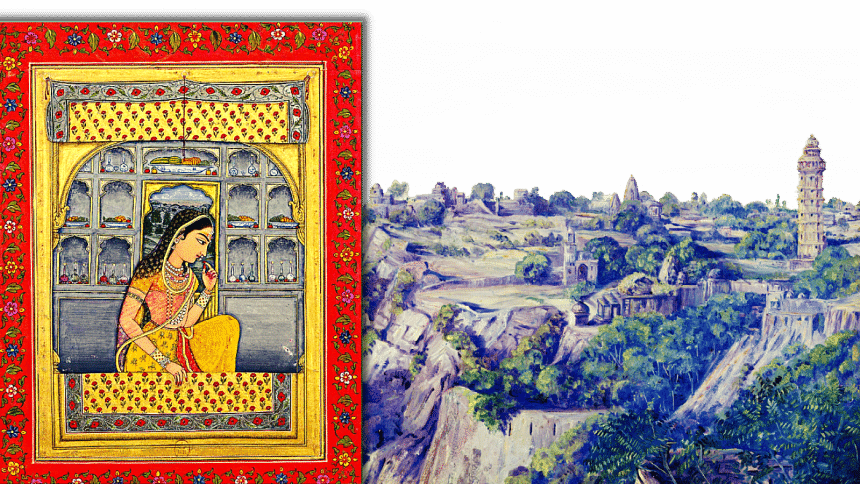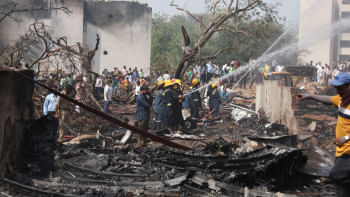Padmavat: Under the lens of history, politics, and literature

Padmavat, a tale of a mythical queen featuring love, honor, and sacrifice, has captured the imagination of readers and audiences for centuries. In 2018, acclaimed Bollywood director Sanjay Leela Bhansali released his film Padmaavat, an adaptation of the epic. The retelling of the story has offered a new interpretation and perspective on the legend, which has been a subject of controversy and political debate. But this is not the first time Padmavat has been used to serve specific agendas. Throughout history, variations of the legend of Padmavat emerged at convenient times to suit the purposes of different polities, castes, and groups.
Having said that, delving deeper into the history, politics, and literature surrounding Padmavat uncovers how the story has been changing with the needs of time and patrons' philosophies.
In 1303, the Delhi Sultanate ruler Alauddin Khalji attacked the Chittor Fort of the Rajput, located in the present-day town of Chittorgarh in Rajasthan. Around 237 years later, some 600 miles away in Awadh, Uttar Pradesh, Sufi Poet Malik Muhammad Jayasi penned the epic poem Padmavat. Many literary traditions in medieval North India featured heroic romances in which princes set out on perilous escapades in order to woo and marry princesses of legendary beauty and wealth. Jayasi's Padmavat was a sufi mystical adaptation of this formula and inspired many translations and adaptations between the 16th and 20th centuries, including Alaol's popular Bengali version in 1648.
Jayasi's epic poem in a nutshell
Padmavati, the daughter of Singhal King Gandharvasen, possesses a talking parrot named Hiraman. The tale starts to unfold as Hiraman escapes execution by fleeing Singhal and ends up at the court of Chittor ruler Ratansen. Learning of Padmavati's exceptional beauty from it, the Rajput king embarks on a journey to pursue her. Ratansen's love for her is invested with spiritual significance as the princess manifests "divine beauty." According to the Sufi tradition, which Jayasi adhered to in his poem, the divine beauty is manifested in many forms and is a reflection of God. Pursuing such beauty requires renunciation of the appetitive self, and Ratansen does so by renouncing his kingdom and becoming an ascetic to seek the divine principle.
After facing several challenges and futile attempts to meet her, the king tries to win Padmavati by performing austerities in a temple. With the intervention of the deities Shiva and Parvati, Ratansen and Padmavati are united at last. The king returns to Chittor with Padmavati by his side.
Meanwhile, in Chittor, a Brahmin courtier named Raghav Chetan resorts to deception to demonstrate his power and is ultimately banished by the king when caught. Determined to take revenge, Raghav cajoles Sultan Alauddin Khalji and informs him about Padmavati's incomparable beauty. He further informs him that Padmavati is a Padmini woman, the kind only to be found in Singhal and, luckily, is in Chittor at present. Alauddin then besieges the Chittor Fort and demands Padmavati. When Ratansen offers to pay a tribute instead, Alauddin captures him deceitfully and returns to Delhi. Padmavati approaches Gora and Badal, influential warriors of the kingdom, for help. Disguised as Padmavati and her female companions, they maneuver their way into the fortress of Delhi in palanquins and free Ratansen.
During Ratansen's absence, Devpal, the Rajput ruler of Kumbhalner, sends a marriage proposal to Padmavati. The king learns about the offense and declares war against Devpal. Ratansen and Devpal kill each other in a duel. Following the death of the king, Nagmati, Ratansen's first wife, and Padmavati commit suicide by self-immolation (Sati). Meanwhile, Alauddin attacks Chittor once again. The men of Chittor fight to the death against Alauddin. Facing an inevitable defeat against the Sultan's army, the women of Chittor commit mass self-immolation (Jauhar) to protect their honor.
Finally, Alauddin acquires nothing but an empty fortress after his victory.
Jayasi influenced by his contemporary times
Indeed, Chittor, in 1303, was conquered by the Delhi Sultan. However, Padmavati is not mentioned in any 14th-century historical accounts. The tale emerges almost two and a half-century later in Jayasi's epic poem, Padmavat–the story of the historic siege of Chittor by Alauddin Khalji: a work that historians consider nothing but an excellent piece of fantasy-fiction literature.
According to historians Aziz Ahmad and Ramya Sreenivasan, Jayasi's contemporary times influenced him heavily. He incorporated several near-contemporary historical or quasi-historical episodes into the characters and plot of his epic. Such as, there might have been a conscious or unconscious confounding in Jayasi's mind of Alauddin Khalji with Ghiyath al-din Khalji (1469-1500), also known as Ghiyath Shah, who had a roving eye and is reported to have undertaken the quest of Padmini, not a particular Rajput princess but the ideal type of woman according to Hindu erotology.
Ghiyath was defeated in a battle in 1488 by a Rajput chieftain named Badal-Gora. It is assumed that Jayasi got the idea for the twin characters–Badal and Gora–from the Rajput chieftain.
In Jayasi's adaptation, the Rajput warriors disguised as Rajput women maneuvered their way into Delhi Fort in palanquins. A similar incident reportedly took place in 1537, three years before Jayasi composed the epic poem. With palanquins full of Afghan soldiers, Sher Shah maneuvered his way into Rohtas Fort, following a similar tactic, and seized it.
Rajasthan
A variety of adaptations emerged after Jayasi's one. The narrative took different forms with different motives based on regions and local groups. Some 49 years after Jayasi's adaptation, in 1589, Hemratan composed the "Gora Badal Padmini Chaupai" ballad in Rajasthan, patronised by local Rajput elites. While Jayasi's epic followed the Sufi ethic, Hemratan's ballad diverged sharply from Jayasi's account, focusing on the valor and bravery of the Rajput.
The Mughal Emperor Akbar had already annexed Chittor by the time Hemratan's adaptation emerged. The worry of the Mughal intervention was looming large over the ununited Rajputs.
Chieftains played a vital role for Rajput kings in ascending the throne. Moreover, they used to look up to the king to exercise power and avail of privileges. One particular move from Akbar hampered the balance of power between the Rajput kings and chieftains. The need arose to strengthen the relationship between them. During such political tension, Padmavat's Rajput adaptation was composed by Hemratan under the patronage of the local Rajput elites. The adaptation focuses on the exemplary bravery and honor of the Rajputs in defending their queen and kingdom, the sacrifice of chieftains Gora and Badal for their king, etc.
Bhansali's plot heavily showcases Rajput's valor and bravery—similar to Hemratan's version. Several scenes of the film were also inspired by this adaptation.
Bengal
During the Colonial period, in 1829, British Officer James Tod compiled his account of the region's history and included the story of Padmavati from a different perspective. He also recasts pre-colonial Rajput traditions from a colonial perspective, which shaped his retelling of the story. He created a religious binary in his narrative of "Hindu" resistance to the onslaught of "Muslim intruders," which is absent in the adaptations of Jayasi or Hemratan.
The influence of James Tod's version, though proved unreliable at present, left a far-reaching impact. In the late 19th century and onward, the new middle-class writers of Bengal--the "bhadrolok"– produced different Bengali adaptations following Tod's account. Rangalal Bandyopadhyay's Padmini Upakhyan (1858), Jyotirindranath Tagore's play "Sarojini ba Chittor Akraman" (1875), Kshirod Prasad Vidyavinod's play "Padmini" (1906), Abanindranath Tagore's Rajkahini (1909) and many more Bengali versions were drawn based on James Tod's account.
Bhadralok writers resorted to Rajput history and traditions to redraw the cultural, religious, and political boundaries between communities in the present. They suggested that the boundaries of community, culture, and conflict between "Hindus" and "Muslims" had their origins in much earlier times and are extended throughout the subcontinent.
Additionally, many of the Padmini narratives appeared in this region at times of rising political consciousness. Padmini Upakhyan by Rangalal was published a year after the 1857 uprising. The Swadeshi movement was at its height when Kshirod Prasad's "Padmini" was published in 1906. Near the end of the movement in 1909, Abanindranath's Rajkahini emerged, following James Tod's narrative, and became popular among school-going students in Bengal.
Padmavati became a symbol of Indian nationalism when the Bengali bhadralok writers used her as an example of a valiant sacrifice made for the motherland.
Modern adaptation
Over the past few years, India has witnessed rising communal tensions between Hindus and Muslims under the influence of the BJP-RSS. Various films (or filmmakers) are adding fuel to that fire for their commercial gain. Bhansali's Padmaavat (2018) is no exception. Such communal tension is not present in Jayasi or Hemratan's adaptations. It was also absent in the black-and-white film Maharani Padmini (1964), directed by Jaswant Jhaveri.
Recently, Bollywood has taken a turn toward historical fiction, which perpetuates the stereotype of the "Muslim Other." These films use historical tropes and historical Muslim characters to shape the dominant public perception of Muslims in India today. However, these films bear little resemblance to the actual historical narratives and contribute to the current hostile environment towards Muslims, fueled by the growing dominance of the Hindu right wing.
In Bhansali's Padmaavat, there is a significant deviation from the source text of Malik Muhammad Jayasi by completely ignoring the history of internal conflicts among Rajput kings. In the book The Ruby in the Dust: Poetry and History of the Indian Padmâvat by Sufi Poet Muhammad Jâyasî (2012), Thomas de Bruijn also mentions the significant role of Rajput conflicts in the epic poem. In the film, Ratansen is killed during single combat with Khalji, whereas in the original version, Rajput King Devpal delivers the final blow to Ratansen. Instead of exploring the complexities of medieval politics, the audience is presented with a simplified narrative that pits "united" Hindu Rajputs against Khalji's lustful and invading Muslim forces.
To avoid controversy, the film Padmaavat was mentioned as inspired by Jayasi's epic poem and claimed to be a fictional story. This is where the complication arises, as Jayasi's epic is also fiction. Over the centuries, the fictional story became part of the history of different communities.
An ever-changing tale can be a dangerous weapon in any era. On some occasions, the story of Padmavat has been used to enforce patriarchal thinking, sometimes to create historical consciousness, and sometimes to maintain positions of power by reconstructing a heroic past for specific groups.
The communal tensions portrayed in the film have a far-reaching impact. Films like this fortify the mass idea that the boundaries of community, culture, and conflict between "Hindus" and "Muslims" are not a recent phenomenon but had their origins in much earlier times. In that regard, the impact of Bhansali's film is crucial, as the visual narration is much more powerful than written narration in creating and retaining the perspective of the mass audience.
Rafid Hossain is a graduate of Economics, University of Dhaka.

 For all latest news, follow The Daily Star's Google News channel.
For all latest news, follow The Daily Star's Google News channel. 








Comments